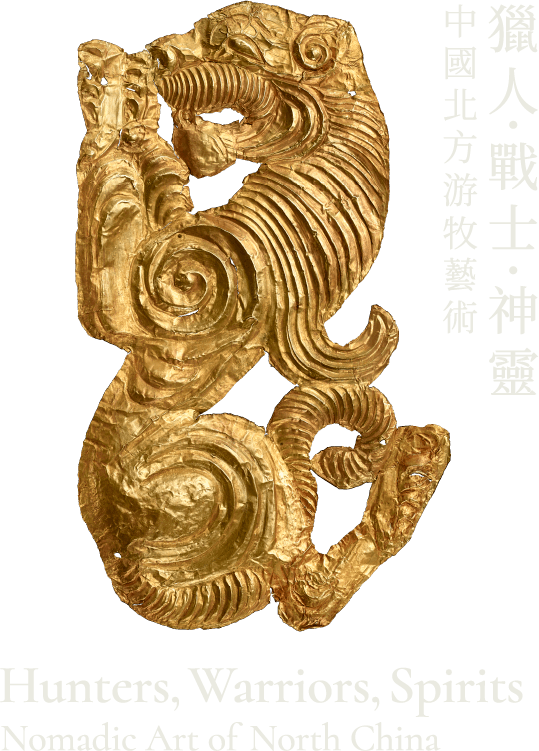Animal Art
The world of the nomads straddled the grassland and the boreal forest, symbolically embodied in the totemic spirits of the grey wolf and the white deer. The nomads relied heavily both on domesticated animals—horses, sheep, cattle, reindeer, camels—and on wild species, like deer, felines, wolves, bears, and raptors. Animal design of North China reflects the nomads’ dual role as herders and hunters and was a crucial part of their visual identity. As warfare became more prominent in nomadic society, the role of the warrior took on ever greater importance. This change is also reflected in the animal art, which began focusing on scenes of combat and predation.
In the Altai region, animal designs are found in the earliest rock art from the late Pleistocene Era. During the Bronze Age, animal-shaped decoration appeared not only on rock surfaces but also on bronze, gold, and silver objects. In the Shang dynasty, the earliest bronze zoomorphic art is seen only on weapons, but by the Western Zhou period it can be found on such other objects as belt plaques, pectorals, torques, and textile appliqués. The development of animal art peaked during the Spring and Autumn and Warring States periods, in what may be called the early nomadic era.
Early Nomad Petroglyphs, Lower Paleolithic Period
Altaï, MongoliaPhotograph
2014
Animal Art
Animal-Shaped Ornaments
The first zoomorphic designs tend to depict one animal in a still or dramatic posture, at rest—crouching and grazing—or in action—galloping in flight or pursuit. The interlocked dualities of action and rest, life and death, predator and prey, express the nomads’ artistic conception of the world.
Powerful animals take pride of place in nomadic art; though the designs are similar across the various nomadic groups, the specific animal portrayed varies according to the species dominant in each topographic region — for instance ibexes and yaks in the mountainous areas, camels and horses in the semi-arid steppe and desert, and forest creatures, like bears, in the Northeast.
Certain animals, notably deer, were glorified by the early nomads. The ubiquity of deer designs and deer stones in Mongolia and South Siberia could be linked to a belief system centred on a “Deer Goddess”. Indeed, modern nomads still often regard the deer as a source of arcane knowledge. Another popular animal category of design includes mythical animals, such as the famous griffin of the Altai, with the body of a horse, the beak of an eagle, and the antlers of a stag.
Animal Art
Complex Forms
Complex animal designs first appear on personal articles of adornment. In general, these designs comprise paired animals, such as conjoined or stacked horses, deer, ibexes, etc., and copulating pairs. Even when individual ornaments contain only one animal, these were meant to be worn together in pairs or groups.
A common theme is that of predatory animals. Tigers, leopards, and wolves are shown killing or eating a victim, like a fawn or hare, and even a stag or horse. Unlike animal combat scenes, these focus explicitly on the act of predation, sometimes using striking and stylised compositions, such as a tiger whose lower half is twisted to face the opposite direction.
Rhinoceros-Shaped Plaque
Gold4th-3rd century B.C.E.
Mengdiexuan Collection
Two Mythical Beasts
Gold leaf5th–3rd century B.C.E.
Mengdiexuan Collection
Plaque with Three Ibex Heads in Swirl Design
BronzeWarring States Period (5th-3rd century B.C.E.)
Hing Chao Collection
Plaques with Coiled Animals
Bronze8th-5th century B.C.E.
Hing Chao Collection
Plaque with Stacked Stags
Gold1st–3rd century C.E.
Mengdiexuan Collection
Tiger-Shaped Plaque
Gold5th–3rd century B.C.E.
Mengdiexuan Collection
Plaque of Tiger Devouring a Deer
Gold5th-3rd century B.C.E.
Mengdiexuan Collection
Leopard-Shaped Plaques
Gold5th-3rd century B.C.E.
Mengdiexuan Collection
Small Knives with Animal-Shaped Hilts
BronzeWestern Zhou – Spring and Autumn Period (11th -5th century B.C.E.)
Hing Chao Collection
Animal-Patterned Short Sword with Openwork Hilt
Bronze6th–4th century B.C.E.
Hing Chao Collection
Belt Ornaments with Bear Motif
SilverLiao Dynasty (907 – 1125 C.E.)
Mengdiexuan Collection
Scabbard Sheet with Frieze of Tigers and Prey
Gold leaf5th-3rd century B.C.E.
Mengdiexuan Collection


























